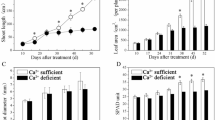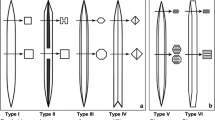Summary
Lemna minor, which produces many calcium oxalate raphide crystals, was grown on media containing in addition to Ca, 200 μM of one of the following divalent cations: Ba, Cd, Co, Mn or Sr. Energy dispersive X-ray analysis showed that only Sr was incorporated into the raphides at levels detectable by the analysis technique. Incorporation of Sr into other insoluble compounds, such as cell wall material, could not be detected. Plant species which form different crystal types in their leaves (Beta vulgaris, crystal sand;Arthrostema ciliatum, druse;Glycine canescens, prismatic) also incorporated Sr into their crystals when grown hydroponically on nutrient medium containing 200 μM Sr.
Axenic cultures ofL. minor were used to examine further the process of Sr incorporation into plant crystals. When grown on nutrient solution with 5 μM Ca, increasing the Sr concentration resulted in increases of the amount of Sr incorporated into the raphide crystals. The ratio of Sr to Ca became greater as the Sr concentration was increased. This ratio change was due to both an increase in the amount of Sr incorporated and a decrease in the Ca incorporated. Analysis of the number of crystal idioblasts formed as a function of Sr concentration shows fewer idioblasts are produced as Sr became high. Competition with Ca and interference of Ca utilization by Sr is indicated.
Similar content being viewed by others
References
Arnott, H. J., Pautard, F. G. E., 1970: Calcification in Plants. In: Biological Calcification (Schraer, H., ed.), pp. 375–446. New York: Appleton-Century Crofts.
Del Cerro, M., Cogen, J., del Cerro, C., 1980: Stevenel's blue, an excellent stain for optical microscopical study of plastic embedded tissues. Microscopica Acta83, 117–121.
Franceschi, V. R., 1984: Developmental features of calcium oxalate crystal sand deposition inBeta vulgaris L. leaves. Protoplasma120, 216–223.
—,Horner, H. T., Jr., 1979: Use ofPsychotria punctata callus in study of calcium oxalate crystal idioblast formation. Z. Pflanzenphysiol.92, 61–75.
— —, 1980: Calcium oxalate crystals in plants. Bot. Rev.46, 361–427.
Frank, E., 1972: The formation of crystal idioblasts inCanavalia ensiformis D.C. at different levels of calcium supply. Z. Pflanzenphysiol.67, 350–358.
—,Jensen, W. A., 1970: On the formation of the pattern of crystal idioblasts inCanavalia ensiformis D.C. IV. The fine structure of the crystal cell. Planta95, 202–217.
Friberg, L., Piscator, M., Nordberg, G. F., Kjellstrom, T., 1974: Cadmium in the Environment. 2nd ed. Cleveland, Ohio: Chemical Rubber Co. Press.
Hillman, R. M., Cully, D. D., Jr., 1978: The uses of duckweed. Amer. Scientist66, 442–451.
Horner, H. T., Jr., Wagner, B. L., 1980: The association of druse crystals with the develo** stomium ofCapsicum annuum (Solanaceae) anthers. Amer. J. Bot.67, 1347–1360.
—,Whitmoyer, R. E., 1972: Raphide crystal cell development in leaves ofPsychotria punctata (Rubiaceae) J. Cell Sci.11, 339–355.
—,Zindler-Frank, E., 1982: Calcium oxalate crystals and crystal cells in the leaves ofRhynchosia caribea (Leguminosae: Papilionoideae). Protoplasma111, 10–18.
Ledbetter, M. C., Porter, K. R., 1970: Introduction to the Fine Structure of Plant Cells. New York: Springer.
Price, J. L., 1970: Ultrastructure of druse crystal idioblasts in leaves ofCercidium floridium Am. J. Bot.57, 1004–1009.
Schötz, F., Diers, L., Bathelt, H., 1970: Zur Feinstruktur der Raphidenzelle. 1. Die Entwicklung der Vakuolen und der Raphiden. Z. Pflanzenphysiol.63, 91–113.
Vallee, B. L., Ulmer, P. D., 1972: Biochemical effects of mercury, cadmium and lead. Ann. Rev. Biochem.41, 91–128.
Van Balen, E., van de Gejn, S. C., Desmet, G. M., 1980: Autoradiographic evidence for the incorporation of cadmium into calcium oxalate crystals. Z. Pflanzenphysiol.97, 123–133.
Zindler-Frank, E., 1975: On the formation of the pattern of crystal idioblasts inCanavalia ensiformis D.C. VII. Calcium and oxalate content of the leaves in dependence of calcium nutrition. Z. Pflanzenphysiol.77, 80–85.
Author information
Authors and Affiliations
Rights and permissions
About this article
Cite this article
Franceschi, V.R., Schueren, A.M. Incorporation of strontium into plant calcium oxalate crystals. Protoplasma 130, 199–205 (1986). https://doi.org/10.1007/BF01276601
Received:
Accepted:
Issue Date:
DOI: https://doi.org/10.1007/BF01276601




